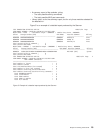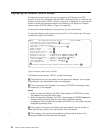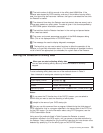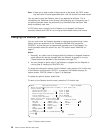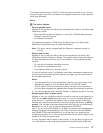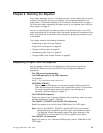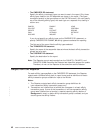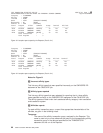The Detector options screen, CAFF02, shows the options available to you. You can
change an option only when the Detector has stopped, unless one of the notes that
follow says otherwise.
Notes:
1 The control options:
v Perform periodic saves
Whether or not you want the affinity data collected to be saved to the affinity data
VSAM files if either:
– More than 300 seconds has passed, or more than 1000 table elements have
changed, since the last save
– You paused the Detector
(The autosave transaction, CAFB, writes the affinity data to the affinity data
VSAM files automatically when you stop the Detector.)
Note: This option can be changed while the Detector is stopped, paused, or
running.
v Restore data on start
Whether or not you want the affinity data to be restored from the affinity data
VSAM files when the Detector is started. This enables affinity data to be added to
the data collected from previous runs of the Detector. If you are gathering data
use this:
– For one set of transaction identifiers at a time
– For one set of commands at a time
– If the Detector is being run at varying times
It is also of particular value if the Detector terminates unexpectedly, because you
do not have to start collecting affinity data all over again; you can start from the
last time data was saved.
Notes:
1. The data restored is only for those affinity types that you have chosen to be
detected (by specifying Y for the affinity type on the CAFF02 screen).
Data is kept on file for all commands, but only the data for the commands
that you have selected to be detected may change, and therefore is restored.
2. You can change this option while the Detector is stopped, paused, or running.
v Multiple signon with the same userid
Whether or not your conventions allow for more than one user to be signed on to
CICS with the same userid at the same time. If so, set the
multiple signon with
same userid
to Y; otherwise, the Detector may incorrectly deduce some affinity
lifetimes and create erroneous affinity transaction groups (also known as affinity
groups). This includes conventions where more than one user is simultaneously
not
signed on; that is, they all take the default userid CICSUSER.
Also, if you are running the Detector in an AOR, the userids examined depend on
whether the userid is propagated from the TOR, or derived from the SESSION
and CONNECTION resource definitions. In the last case, you should set the
multiple signon option to Y if your conventions allow the same AOR userids to be
signed on to CICS at the same time.
It is very important that this option is set correctly. If you are about to start a new
run of the Detector, and intend restoring data from the affinity data VSAM files,
Chapter 5. Running the Detector 37



